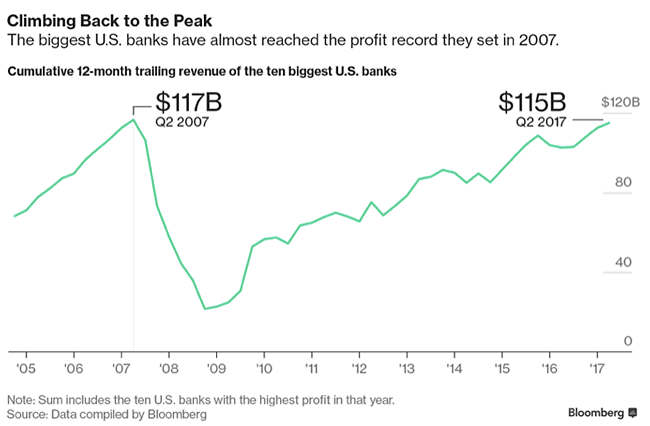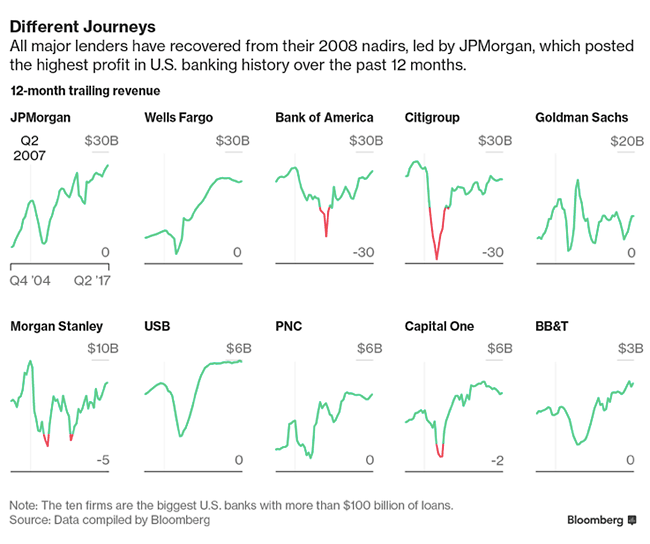
The barbarians are standing right outside the bank waiting and biding their time. Just ask anybody. Community banks, middle market banks and especially the nation’s biggest banks are taking on risk like a sinking ship taking on water. Ask a lay man off the street as to why and you might get a vague answer about the economy or politics, but ask an industry professional off the record and you will get the truth. We are in a low interest rate environment, record stock market and strong economy that is generating record earnings for banks – they don’t want it to stop. According to Bloomberg News: “The last time big U.S. banks made so much money, the financial world was heading toward the brink of collapse.”

The 2007 figure includes profits from Wall Street giants that were independent at the time, such as Merrill Lynch & Co. and Bear Stearns Cos., but were acquired by larger rivals while succumbing to the meltdown. The 10 firms on the list for this year are U.S. banks with the highest net income that hold at least $100 billion of loans. That group now generates more than $57 million of profit per working hour.

For avoidance of doubt, the purpose of this article is to not forecast the next great recession or be a doomsayer. The main takeaway is that the private credit markets are headed toward a bubble as the current trends are not new. Since I started at Super G three years ago with the thesis that there exists a void in the credit market banks have only booked more assets. Since that time billions have been raised to gladly help banks shed assets, but the mass exodus has yet to come. Many non-bank ABL lending professionals who have since joined or had their firms acquired by banks fondly remember the post-2008 recession time period when booking new business was as simple as picking up the phone.
The dirty truth is banks and the rest of us know it will happen, but the hard part is none of us know when. Go to any lender networking function and it’s all anyone talks about, but no one has the crystal ball to pick the quarter. Outside of exogenous geopolitical events it will not be next quarter or the one after, but it will for sure come like any market cycle. The difference is now there are barbarians lined up at the gates waiting like never before. Market consolidation has created a new playing field of non-bank ABLs and credit funds that have raised a war chest of capital to welcome these bank kick outs with open arms. These folks have been planning and waiting for the next cycle at every level of the debt capital markets.
Here are some of the new firms that have been formed or aggressively hired in the past few years to help with this next cycle: Super G Capital, StoneGate, Northmill, Riseline, LQD, Siena, Encina and CIT Northbridge. Many of the senior professionals at these firms clearly remember the cycle of 2008 when banks could not shed assets fast enough. The tricky part is that capital is fluid and you need to use it or lose it as is human capital to some extent. It’s a hard act to balance raising capital and hiring people before the storm hits. The good firms find deals and new niches in any markets. Here at Super G, we have several divisions to counter the ebb and flow of stretch lending behind ABLs. The software lending marketing is another good example of a hot sector.
It also worth noting that banks have been preparing a first line of defense for what will surely happen at some point and that has been to go out acquire ABL firms or bolster internal groups. City National recently formed a group as did California Bank & Trust. Others such as Texas Capital Bank poached top talent from JP Morgan. UMB Bank acquired Marquette and the list goes on. Some of these moves were non-market based meaning these banks wanted in the ABL business, but the complement is surely there when C&I deals have to transition either to a bank owned ABL or to a non-bank. There should be enough to go around as many bank owned ABLs are currently busy given their competitive advantage of low cost of funds and aggressive appetite of banks in this environment.
A side-effect of this glut of non-bank capital has been that good deals have never been so hotly contested and firms have provided excess capital to marginal credits as part of feeling forced to put capital to work. The clear result is good deals booked by non-bank credit funds are getting low pricing with no-to-minimal equity and a lot of marginal deals are getting booked. There is an uneven balance on both ends of the credit spectrum. The uneven balance occasionally creates pent up frustration from the side with less assets. Anyone not seeing this trend has been hiding in the woods or simply not attending any functions with other firms.
From a borrowers perspective, its like going from the Ritz Carlton to jail. One day you wake up and all you have to worry about is a quarterly review and relaxing lunch with your relationship manager and the next day you are dealing with an interest that is double or triple and weekly or monthly reporting including constant borrowing base submissions. It’s going to the Ritz Carlton and waking up in a Motel 6. This will happen and should happen as many of these companies have been getting the benefit of a low tide environment and relaxed regulatory enforcement.
Are you a barbarian or a gate keeper? Get ready for the gates to open.